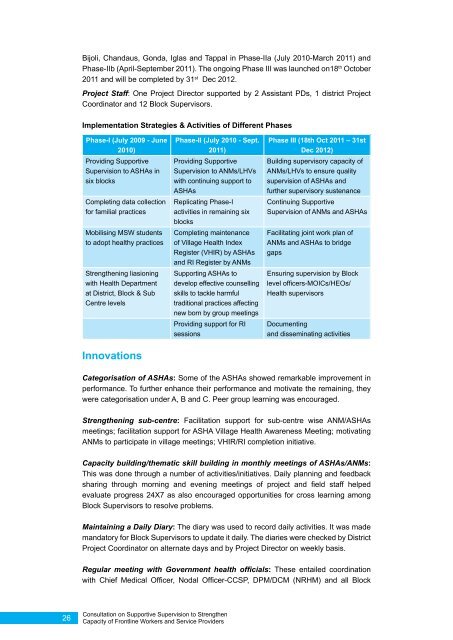Download the complete report - Unicef
Download the complete report - Unicef
Download the complete report - Unicef
Create successful ePaper yourself
Turn your PDF publications into a flip-book with our unique Google optimized e-Paper software.
Bijoli, Chandaus, Gonda, Iglas and Tappal in Phase-IIa (July 2010-March 2011) and<br />
Phase-IIb (April-September 2011). The ongoing Phase III was launched on18 th October<br />
2011 and will be <strong>complete</strong>d by 31 st Dec 2012.<br />
Project Staff: One Project Director supported by 2 Assistant PDs, 1 district Project<br />
Coordinator and 12 Block Supervisors.<br />
Implementation Strategies & Activities of Different Phases<br />
Phase-I (July 2009 - June<br />
2010)<br />
Providing Supportive<br />
Supervision to ASHAs in<br />
six blocks<br />
Completing data collection<br />
for familial practices<br />
Mobilising MSW students<br />
to adopt healthy practices<br />
Streng<strong>the</strong>ning liasioning<br />
with Health Department<br />
at District, Block & Sub<br />
Centre levels<br />
Innovations<br />
Phase-II (July 2010 - Sept.<br />
2011)<br />
Providing Supportive<br />
Supervision to ANMs/LHVs<br />
with continuing support to<br />
ASHAs<br />
Replicating Phase-I<br />
activities in remaining six<br />
blocks<br />
Completing maintenance<br />
of Village Health Index<br />
Register (VHIR) by ASHAs<br />
and RI Register by ANMs<br />
Supporting ASHAs to<br />
develop effective counselling<br />
skills to tackle harmful<br />
traditional practices affecting<br />
new born by group meetings<br />
Providing support for RI<br />
sessions<br />
Phase III (18th Oct 2011 – 31st<br />
Dec 2012)<br />
Building supervisory capacity of<br />
ANMs/LHVs to ensure quality<br />
supervision of ASHAs and<br />
fur<strong>the</strong>r supervisory sustenance<br />
Continuing Supportive<br />
Supervision of ANMs and ASHAs<br />
Facilitating joint work plan of<br />
ANMs and ASHAs to bridge<br />
gaps<br />
Ensuring supervision by Block<br />
level officers-MOICs/HEOs/<br />
Health supervisors<br />
Documenting<br />
and disseminating activities<br />
Categorisation of ASHAs: Some of <strong>the</strong> ASHAs showed remarkable improvement in<br />
performance. To fur<strong>the</strong>r enhance <strong>the</strong>ir performance and motivate <strong>the</strong> remaining, <strong>the</strong>y<br />
were categorisation under A, B and C. Peer group learning was encouraged.<br />
Streng<strong>the</strong>ning sub-centre: Facilitation support for sub-centre wise ANM/ASHAs<br />
meetings; facilitation support for ASHA Village Health Awareness Meeting; motivating<br />
ANMs to participate in village meetings; VHIR/RI completion initiative.<br />
Capacity building/<strong>the</strong>matic skill building in monthly meetings of ASHAs/ANMs:<br />
This was done through a number of activities/initiatives. Daily planning and feedback<br />
sharing through morning and evening meetings of project and field staff helped<br />
evaluate progress 24X7 as also encouraged opportunities for cross learning among<br />
Block Supervisors to resolve problems.<br />
Maintaining a Daily Diary: The diary was used to record daily activities. It was made<br />
mandatory for Block Supervisors to update it daily. The diaries were checked by District<br />
Project Coordinator on alternate days and by Project Director on weekly basis.<br />
Regular meeting with Government health officials: These entailed coordination<br />
with Chief Medical Officer, Nodal Officer-CCSP, DPM/DCM (NRHM) and all Block<br />
26<br />
Consultation on Supportive Supervision to Streng<strong>the</strong>n<br />
Capacity of Frontline Workers and Service Providers

















